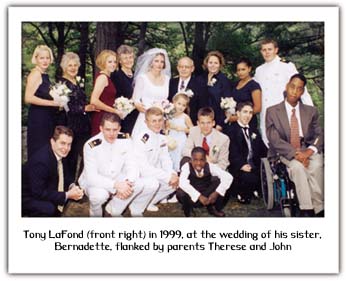 |
 |
 |
 |
 |
 |
 |
 |
 |
 |
 |
 |
 |
 |
 |
 |
 |
 |
|
My Family |
|
|
|
 |
|
|
|
 |
|
|
|
|
|
The LaFond family of Bogota, N.J., is used to being stared at. Perhaps it's because some of John and Therese LaFond's children are white, some are black and some are of mixed race. Or it could be because some of their children have physical disabilities and one son uses a wheelchair. |
|
|
|
Those "regular problems" include multiple surgeries for some of the children and negative community reaction to the racial mix of the household. Therese's fought with the school system, which placed Tony with mentally disabled children for a few years, causing him to lose some ground in his education. To accommodate the growing family, they simply built in more bunk beds and everybody pitched in to help. |
|
|
|
|
Or maybe it's because there are 14 of them. The family numbers 16 with parents, 19 with grandchildren, over 20 with sons-in-law ... at last count.
The LaFonds had eight children but eight wasn't enough. When they decided to adopt, they were drawn to "special needs" kids, the children who used to be called "unadoptable" because they were older or had disabilities or other problems. That made them all the more appealing to the LaFonds. |
|
|
|
|
|
|
That "no big deal" attitude and sense of humor seem to work for the whole family. With the ninth child starting college this year, Therese says, "Our children are really happy. They are successful and doing well." Therese says her children are surprised by things that other people consider problems. And she believes they're more tolerant, understand-ing and patient because of growing up in a large, diverse family.
One daughter called her mother from college and said, "My family is wonderful because nobody has anything to talk about in psychology class, and any time there is a problem to discuss I can bring up one of my brothers or sisters. I am getting such a good grade." |
|
|
|
|
All of the LaFonds' six adopted children have disabilities, ranging from missing bones to fetal alcohol syndrome. They found some of the children through the state's adoption program, and Anthony was placed with them through Spaulding for Children, considered the nation's first agency helping "hard-to-place" children find homes.
At 4 years old, Anthony (Tony) weighed 24 pounds and couldn't walk. His congenital muscular dystrophy was apparently more than his birth mother could handle, so he became available for adoption. Doctors predicted he might live to age 6. |
|
|
|
|
|
|
Besides having an obvious love of children, Mom sees her huge family as "sort of energizing. I find children fascinating. I like their frankness, and if you look awful they will come right out and tell you. I enjoy being with children. My husband enjoys going to work."
Could the urge to adopt be hereditary? Or is it due to environmental influence? Whatever the answer, some of the LaFond children have echoed their parents' attitude: "They said, why not? If we all took one child, a child who needs you, it's no big deal."
One daughter who has two birth children has also adopted an infant. So far |
|
|
|
|
Today, Tony's 18 and finishing high school. His mother brags about his keen sense of humor, his intelligence and his good attitude.
"With Tony, what I find interesting is that he has never once complained about his disability, and he is severely disabled. He can't even brush his teeth himself," Therese says. "One time when he was about 10 we thought we might get a handicap sticker for our car just so we could park closer for Tony. And Tony said to us, 'Who in the family is handicapped?'"
To people who find her family remarkable, Therese says, "It didn't seem hard, though to be truthful there were some hard times when they were sick." |
|
|
|
|
|
|
HOME |
|
|
|
|
|
But for the most part, "We have fun. We've made some wonderful acquaintances. There's been some disappointments, but I would say that what we have gotten out of it is much greater than we had anticipated. We went into it thinking, well, it would be a nice thing to do. We haven't had any catastrophic problems, just the regular problems." |
|

